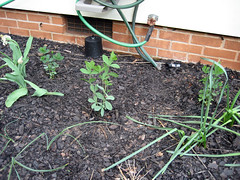Baptisia (False Indigo)
Baptisia is the common name for a Spring-flowering family of perennial plants exhibiting lupine-like flowers atop dense blue-green foliage. A native to the US, baptisia is a favorite among lupine lovers since it is generally considered easier to grow than lupine. Sometimes referred to as false indigo for its fabric-dyeing qualities, baptisia is actually a member of the pea family, although its flowers are displayed at the end of sturdy branches instead of vines.
There are many types of baptisia available to the home gardener. Height variations range from 1'-7' and blooms are available in blue, white and yellow. Baptisia is hardy from zones 3-9 and blooms in late Spring or early Summer. The deep red seed pods provide Winter interest to the garden, but the plants do eventually die back to the ground in the coldest months of the season. Baptisia flourishes in full sun to partial shade, and is highly drought tolerant due to the long taproot that drills deep into the soil to collect water. The plants are non-intrusive, very long-lived and not susceptible to diseases or pests.
Baptisia makes a beautiful focal point for the Spring garden and its dense foliage provides a lovely filler for the Summer garden. Although its long tree-like taproot enables great drought tolerance, it also makes the plant resentful to transplanting, so once established, this plant should not be disturbed.
I planted three blue baptisia late last Spring. As you can see from this photo, the largest of the three plants was about 12" in height. I wanted these shrub-like plants to help hide the garden hose eyesore, and I expected it to take a couple years for these notoriously slow-starters to reach an adequate height.

The plants died back in the Winter, which startled me a bit, and I was relieved when they starting emerging from the cool Spring soil. The plants grew quickly and the largest is now 4' in height and the hose is completely hidden. You can see baptisia coupled with White Swan coneflower and veronica in this photo.

I am disappointed to report that the plants did not bloom this year, but I am pleased with their growth rate. These plants are in a mostly shaded area but still have great color and are growing well. The tallest plant receives the most sun, because it is tall enough to reach through the shade and soak in the warm Summer rays throughout the day. I did have to support the tallest plant to keep the stalks from tipping, but I expect it will grow stronger in the future and not require this support. I highly recommend this plant for the back or middle of the border, particularly in dry areas that may have proven to provide sub-prime conditions for other plants.
Labels: asheville, baptisia, gardening, perennials

2 Comments:
I WAS going to ask if you can still GET TO the hose, but since you cannot water, I guess that is no concern.
Will you eat the peas from these plants?
I actually can still get to the hose, but it takes some work! These plants don't actually produce peas. They just have flowers that look like the same flowers on a pea vine. No pea ever forms though.
Post a Comment
Subscribe to Post Comments [Atom]
<< Home